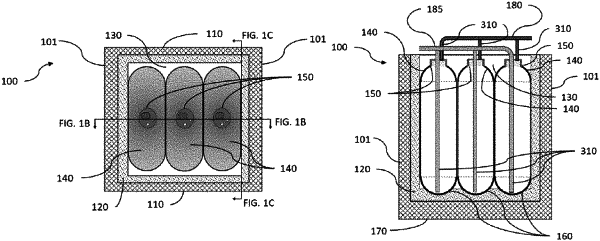| CPC F17C 3/022 (2013.01) [F17C 2203/0629 (2013.01); F17C 2221/012 (2013.01); F17C 2221/013 (2013.01); F17C 2223/0161 (2013.01)] | 23 Claims |

|
1. A composite tank apparatus for fluid containment at pressures at or near ambient to moderate pressures comprising:
a) an array of at least two flat-sided co-dependent cells with relatively thin skin cell walls made of metallic or non-metallic materials, each of the at least two flat-sided co-dependent cells having at least two flat wall panel portions connected by radiused sections arranged such that all of the flat wall panel portions of the at least two flat-sided co-dependent cells are either in flush contact with flat wall panel portions of adjacent ones of the at least two flat-sided co-dependent cell or in flush contact with flat supporting panels of an enclosing structure (or thermal insulating material lining interior flat surfaces of the enclosing structure) enclosing the array of at least two flat-sided co-dependent cells, each of the at least two flat-sided co-dependent cells having a top and a bottom cap connected respectively to top and bottom ends of the at least two flat wall panel portions comprising flat walls joined by the radiused sections;
b) the at least two flat-sided co-dependent cells sealed with each other around a perimeter of at least one matching pair of lightening through-wall holes provided in the flush-contacting flat wall panel portions of the adjacent ones of the at least two flat-sided co-dependent cells in the composite tank, the perimeter of all the pairs of lightening through-wall holes sufficiently sealed to structurally resist relative movement and prevent leakage of fluid from containment;
c) the enclosing structure having an interior surface and an exterior surface, the enclosing structure configured to provide environmental isolation with sufficient structural strength and with sufficient rigidity to support exterior flat side panel portions of the at least two flat-sided co-dependent cells at exterior portions of the array of at least two flat-sided co-dependent cells such that, when internal pressure is established within the array of at least two flat-sided co-dependent cells at a targeted level for operations or survival, the at least two flat-sided co-dependent cells of the array are prevented from over-expanding and displacing; and
d) optionally, one or more layers of thermally insulating material lining the interior surface or the exterior surface of the enclosing structure.
|